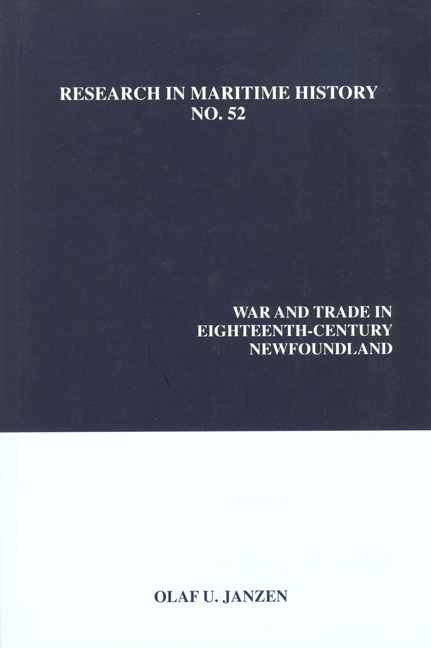Book contents
- Frontmatter
- Table of Contents
- About the Author
- Introduction
- “‘A World Embracing Sea:’ The Oceans as Highway, 1604-1815”
- “Of Consequence to the Service:' The Rationale behind Cartographic Surveys in Early Eighteenth-Century Newfoundland”
- “The Problem of Piracy in the Newfoundland Fishery in the Aftermath of the War of the Spanish Succession”
- “A Scottish Sack Ship in the Newfoundland Trade, 1726-1727”
- “'Une petite Republique' in Southwestern Newfoundland: The Limits of Imperial Authority in a Remote Maritime Environment”
- “The Illicit Trade in English Cod into Spain, 1739-1748”
- “Un Petit Dérangement: The Eviction of French Fishermen from Newfoundland in 1755”
- “The French Raid upon the Newfoundland Fishery in 1762: A Study in the Nature and Limits of Eighteenth-Century Sea Power”
- “Showing the Flag: Hugh Palliser in Western Newfoundland, 1763-1766”
- “The Royal Navy and the Interdiction of Aboriginal Migration to Newfoundland, 1763-1766”
- “The Royal Navy and the Defence of Newfoundland during the American Revolution”
- “The American Threat to the Newfoundland Fisheries, 1776-1777”
- Appendix
“Of Consequence to the Service:' The Rationale behind Cartographic Surveys in Early Eighteenth-Century Newfoundland”
- Frontmatter
- Table of Contents
- About the Author
- Introduction
- “‘A World Embracing Sea:’ The Oceans as Highway, 1604-1815”
- “Of Consequence to the Service:' The Rationale behind Cartographic Surveys in Early Eighteenth-Century Newfoundland”
- “The Problem of Piracy in the Newfoundland Fishery in the Aftermath of the War of the Spanish Succession”
- “A Scottish Sack Ship in the Newfoundland Trade, 1726-1727”
- “'Une petite Republique' in Southwestern Newfoundland: The Limits of Imperial Authority in a Remote Maritime Environment”
- “The Illicit Trade in English Cod into Spain, 1739-1748”
- “Un Petit Dérangement: The Eviction of French Fishermen from Newfoundland in 1755”
- “The French Raid upon the Newfoundland Fishery in 1762: A Study in the Nature and Limits of Eighteenth-Century Sea Power”
- “Showing the Flag: Hugh Palliser in Western Newfoundland, 1763-1766”
- “The Royal Navy and the Interdiction of Aboriginal Migration to Newfoundland, 1763-1766”
- “The Royal Navy and the Defence of Newfoundland during the American Revolution”
- “The American Threat to the Newfoundland Fisheries, 1776-1777”
- Appendix
Summary
This essay examines two cartographic surveys carried out during the eighteenth century on the southern coast of Newfoundland. The surveys were conducted ostensibly for the benefit of trade and commerce. It is the contention of this paper, however, that of equal importance in the decision to commission the expeditions were questions of sovereignty. The two surveys – by William Taverner (1714-1715) and Lt. John Gaudy (1716) – were immediate responses to the dramatic changes that followed the Treaty of Utrecht (1713) by which France conceded British sovereignty over all of Newfoundland and gave up the right to maintain any permanent settlement there. As the French withdrew, the British moved swiftly to establish their authority in Placentia Bay, St. Pierre and the south coast of the island. The reluctance of British fishermen to move into the region, together with evidence that French fishing and commerce persisted there, contributed to the urgency of the surveys.
The issue of sovereignty in Newfoundland, and hence the desire for cartographic clarification, arose primarily because until the eighteenth century no single country claimed exclusive control over the island. Since its beginnings early in the sixteenth century, the Newfoundland fishery had been an international activity, attracting French, Portuguese, Basque, English and Dutch fishing and trading vessels. By the second half of the seventeenth century, however, English and especially French fishermen were the only significant participants. The fishing crews of both nations had established themselves in fairly specific regions by then as well. Thus, the English dominated the Avalon Peninsula from Cape Race to Cape Bonavista (the so-called “English Shore”); French fishermen predominated along the south coast, with a fortified settlement at Plaisance. There were also important installations on the island of St. Pierre, as well as the “Petit Nord,” as the region between Cape St. John and Quirpon was known. For their part, fishermen from the Basque region of southwestern France made the west coast of the island their special preserve.
The precise limits of these fishing zones had been established by custom long before emerging state machinery became involved. Indeed, throughout the seventeenth century, the English government adopted the position that the North American fisheries should be encouraged but not rigorously administered by the state. Though France established an outpost at Plaisance after 1660 to support the fishery, no attempt was made to extend the effective range of French authority beyond Placentia Bay.
- Type
- Chapter
- Information
- War and Trade in Eighteenth-Century Newfoundland , pp. 17 - 30Publisher: Liverpool University PressPrint publication year: 2013



